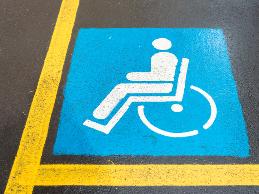On This Page
About Respiratory Impairments
Respiratory impairment is a generic term that refers to a number of medical conditions that can affect the respiratory system and may result in limitations such as labored breathing or asthma attacks, fatigue and difficulty with mobility, heightened sensitivity to ordinary substances and chemicals, and compromised immunity to infection.
The following is a non-comprehensive list of many of the medical conditions that may result in respiratory impairments: Allergies, Asthma, Chemical Sensitivity (MCS), Chronic Obstructive Pulmonary Disease, Cystic Fibrosis, Environmental Illness (EI), Fragrance Sensitivity, Lung Cancer, Pulmonary Sarcoidosis, Tuberculosis, Emphysema, Pulmonary Hypertension, Latex Allergy, and AIDS Related Lung Disease.
Respiratory Impairments and the Americans with Disabilities Act
The ADA does not contain a definitive list of medical conditions that constitute disabilities. Instead, the ADA defines a person with a disability as someone who (1) has a physical or mental impairment that substantially limits one or more "major life activities," (2) has a record of such an impairment, or (3) is regarded as having such an impairment. For more information about how to determine whether a person has a disability under the ADA, see How to Determine Whether a Person Has a Disability under the Americans with Disabilities Act Amendments Act (ADAAA).
Accommodating Employees with Respiratory Impairments
People with respiratory impairments may develop some of the limitations discussed below, but seldom develop all of them. Also, the degree of limitation will vary among individuals. Be aware that not all people with respiratory impairments will need accommodations to perform their jobs and many others may only need a few accommodations. The following is only a sample of the possibilities available. Numerous other accommodation solutions may exist.
Questions to Consider:
- What limitations is the employee experiencing?
- How do these limitations affect the employee and the employee’s job performance?
- What specific job tasks are problematic as a result of these limitations?
- What accommodations are available to reduce or eliminate these problems? Are all possible resources being used to determine possible accommodations?
- Once accommodations are in place, would it be useful to meet with the employee to evaluate the effectiveness of the accommodations and to determine whether additional accommodations are needed?
- Do supervisory personnel and employees need training?
Key Accommodations
Environmental Triggers: Some respiratory impairments are aggravated by environmental triggers.
- Maintain a clean and healthy work environment
- Condition, heat, dehumidify, or add moisture to the air as appropriate
- Provide additional rest breaks for the individual to get fresh air or take medication
- Create a smoke and fragrance-free work environment
- Allow for alternative work arrangements when construction is taking place
- Use alternative pest management practices
- Allow for alternative means of communication such as telephone, e-mail, instant messaging, fax, or memos
Accessibility: An individual who experiences respiratory limitations may have difficulty performing activities that require gross motor movement, such as walking long distances, or performing activities that require excessive physical activity. It may be necessary to address access concerns for an individual who has difficulty approaching the work facility, moving around the facility, getting to work, or traveling as an essential job function.
- Provide an entrance free of steps with doors that open automatically or that have a maximum opening force of five pounds
- Provide an accessible route of travel to and from work areas used by the individual throughout the work environment
- Consider providing a scooter or motorized cart for the employee to use for long distances if the employee does not already use a mobility aid
- Move the individual’s workstation closer to equipment, materials, and rooms the individual uses frequently
- Modify the workstation to accommodate a wheelchair, scooter, or the use of oxygen therapy equipment
- Arrange the workstation so materials and equipment are within reach range
- Provide restrooms that are easily accessed from the individual's workstation
- Review emergency evacuation procedures
Policy Modification: Due to the unpredictable nature of the onset of respiratory limitations, an individual may have difficulty maintaining regular attendance or a regular schedule.
- Modify the location where work is performed
- Modify the attendance policy
- Provide leave as an accommodation
- Provide a modified or part-time work schedule
- Provide breaks
Air Quality: The U.S. Environmental Protection Agency (EPA) provides suggestions for improving indoor air quality in its article, An Office Building Occupant's Guide to Indoor Air Quality. Employers should keep indoor air quality concerns in mind for employees with and without respiratory impairments. Good IAQ can improve worker productivity for everyone.
- Provide an office or workspace that has working windows
- Maintain the heating, ventilation, and air conditioning (HVAC) system
- Test indoor air quality
- Use air purification systems throughout the building or in personal workstations
- Reduce workplace pollutants
- Adjust indoor temperature to meet the individual’s needs
- Institute a fragrance-free workplace
- Provide pre-notification of construction and cleaning in the workplace
- Use non-toxic building materials, furnishings, supplies, and flooring
- Use non-toxic solvents, primers, stains, paints, etc.
Accommodation Ideas:
Situations and Solutions:
The following situations and solutions are real-life examples of accommodations that were made by JAN customers. Because accommodations are made on a case-by-case basis, these examples may not be effective for every workplace but give you an idea about the types of accommodations that are possible.
JAN Publications & Articles Regarding Respiratory Impairments
Publications
Consultants' Corner Articles
Related Disabilities
Articles
- No Articles available for Respiratory Impairments





